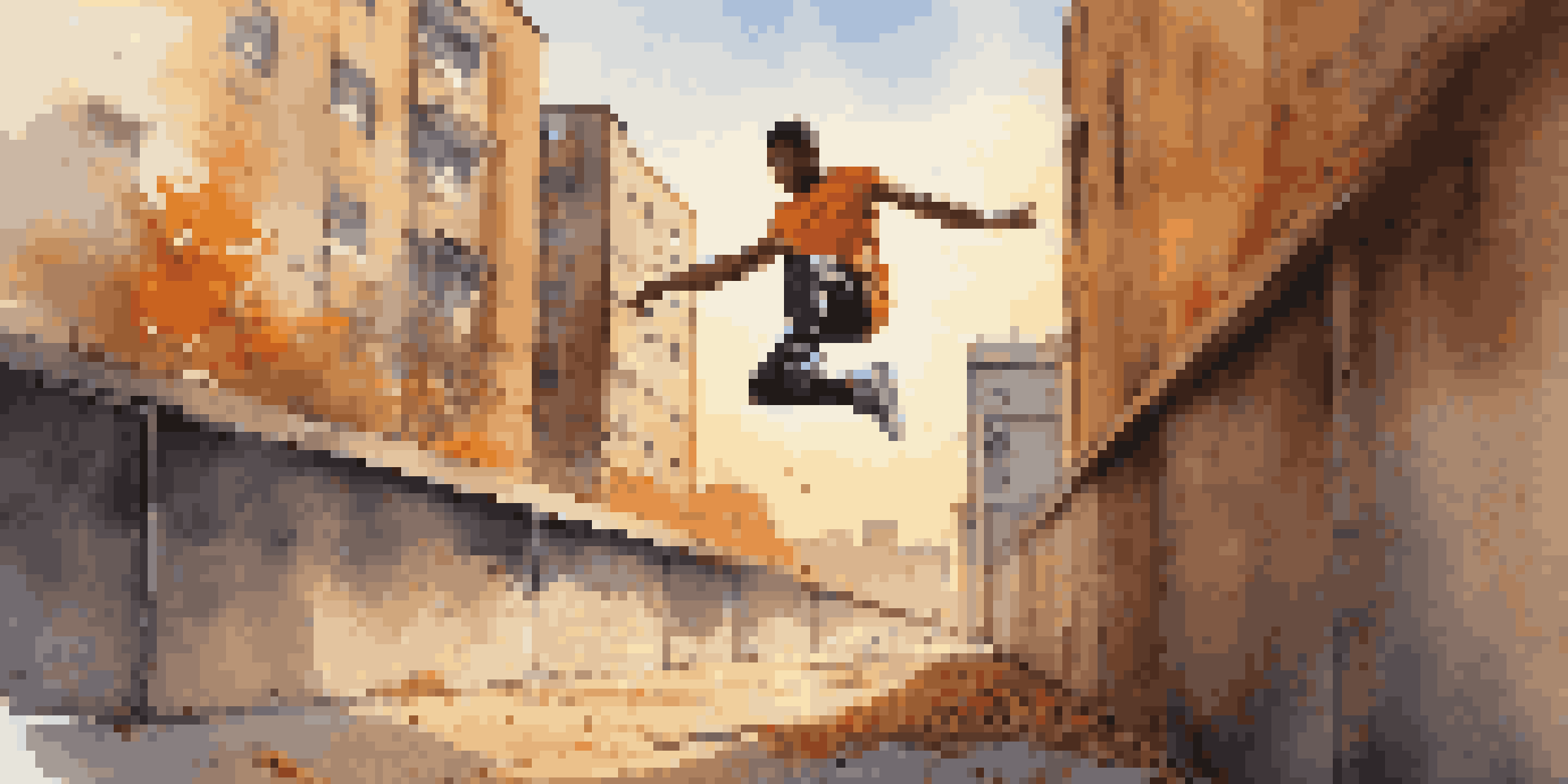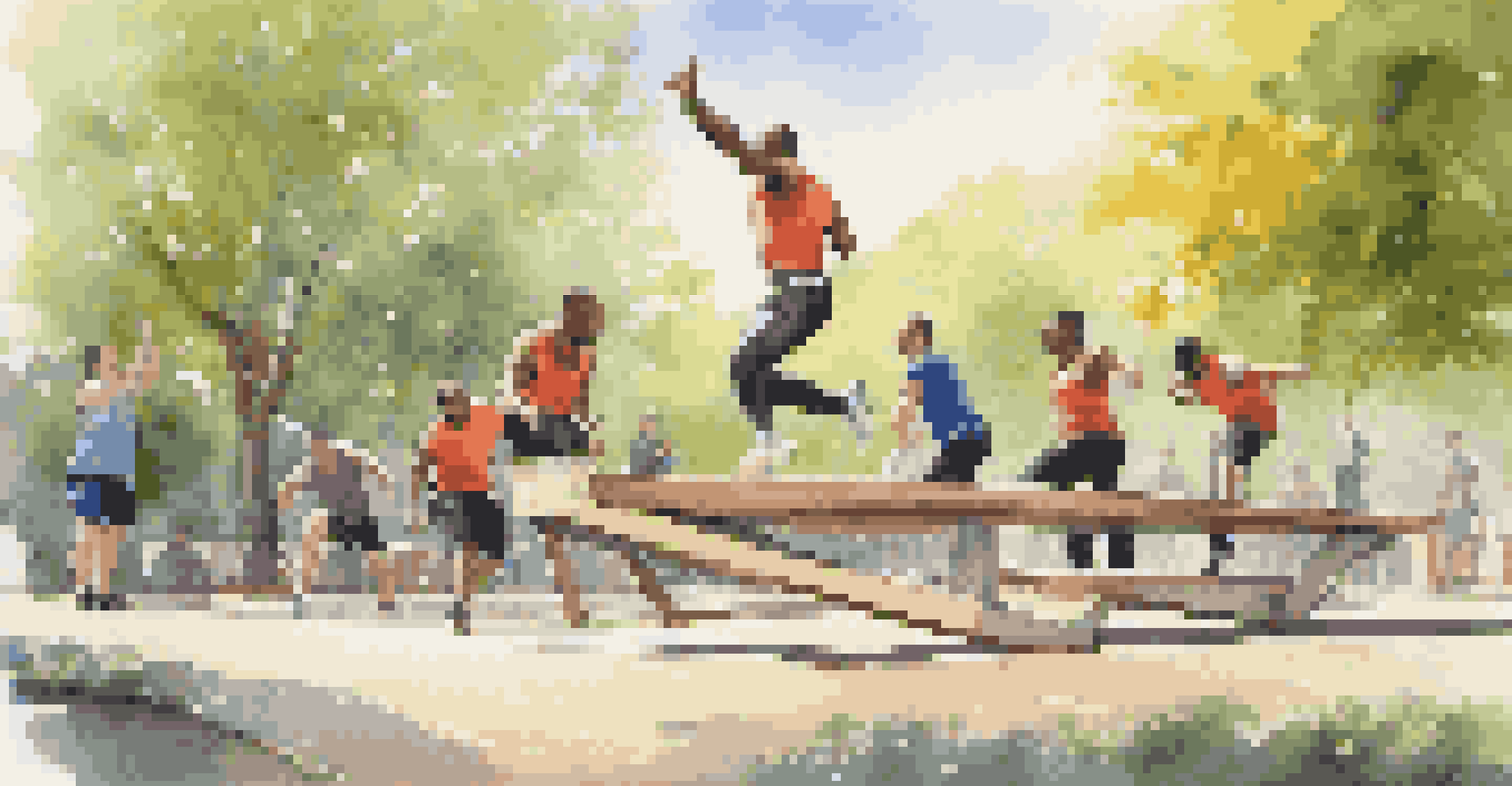Parkour Training Drills: Effective Ways to Improve Skills

Understanding the Basics of Parkour Training
Before diving into drills, it's essential to grasp the fundamentals of parkour. This discipline emphasizes efficient movement through environments, combining running, jumping, and climbing. Understanding these basics not only enhances performance but also builds a foundation for more advanced techniques.
The only way to discover the limits of the possible is to venture a little way past them into the impossible.
One key aspect of parkour is body awareness, which allows you to navigate obstacles confidently. As you train, focus on how your body interacts with its surroundings. This awareness will help you execute movements with greater precision and control, leading to a successful parkour journey.
Lastly, safety should always be a priority. Start with simple movements and gradually progress to more challenging drills. This approach ensures you build strength and confidence while minimizing the risk of injury.
Warm-Up Exercises to Prepare for Training
Warming up is crucial before any physical activity, and parkour is no exception. Incorporating dynamic stretches and mobility exercises into your routine prepares your body for the demands of training. This can include leg swings, arm circles, and hip openers to increase your range of motion.

Additionally, consider incorporating light cardio, such as jogging or skipping, to elevate your heart rate. This increase in blood flow helps reduce the risk of injury and primes your muscles for action. It’s like revving up your engine before hitting the road!
Fundamentals of Parkour Training
Understanding the basics of parkour, including body awareness and safety, lays a solid foundation for effective training.
Finally, don’t forget to engage your core during your warm-up. A strong core enhances stability and balance, which are vital components in parkour. By investing time in a proper warm-up, you set the stage for an effective training session.
Basic Jumping Drills to Enhance Technique
Jumping is a fundamental skill in parkour that requires both power and technique. Start with basic drills like standing jumps and precision jumps, focusing on landing softly and maintaining control. These drills not only improve your jumping ability but also build confidence in your movements.
Success is where preparation and opportunity meet.
As you progress, try incorporating height into your jumps. Use a low platform to practice jumping and landing safely, gradually increasing the height as your skills develop. This method builds strength and teaches you how to gauge your jumps effectively.
Moreover, practicing jump combinations can elevate your skills further. For instance, try jumping from one obstacle to another, focusing on maintaining flow and rhythm. This approach simulates real parkour scenarios and prepares you for various environments.
Vaulting Techniques for Overcoming Obstacles
Vaulting is a key component of parkour that allows you to navigate obstacles smoothly. Start with basic vaults like the monkey vault, which involves placing your hands on the obstacle and swinging your legs through. Practicing this technique builds upper body strength and confidence.
Next, explore variations such as the speed vault and the kong vault. Each vault has its own unique approach, so take the time to master them individually. This variety not only keeps training exciting but also prepares you for different types of obstacles.
Importance of Warm-Up Exercises
Incorporating dynamic stretches and light cardio into your warm-up routine prepares your body for the physical demands of parkour.
Remember, the key to successful vaulting is practice and patience. Focus on your form and technique, as this will lead to smoother and more efficient movements. With consistent training, vaulting will become second nature.
Rolling Techniques for Safe Landings
Mastering the parkour roll is essential for safe landings. A proper roll helps dissipate the impact from jumps and prevents injuries. Start by practicing on a soft surface, focusing on the technique of rolling from one shoulder to the opposite hip.
As you gain confidence, gradually introduce height into your jumps before rolling. This progression allows you to practice rolling from different heights while ensuring your safety. Just remember, the roll should feel fluid and natural, like a graceful transition from air to ground.
Incorporating rolls into your training not only enhances safety but also improves overall agility. The more you practice, the more instinctive your roll will become, giving you the freedom to challenge yourself further in your parkour journey.
Strength and Conditioning Exercises for Parkour
Strength and conditioning are the backbone of effective parkour training. Incorporating exercises like squats, lunges, and push-ups builds the essential muscles needed for jumping and climbing. Think of these exercises as the building blocks of your parkour skills, laying a solid foundation for more advanced movements.
Additionally, consider including plyometric exercises, such as box jumps or tuck jumps. These explosive movements develop power and speed, both crucial for parkour. By mixing strength training with plyometrics, you’ll create a well-rounded fitness routine that enhances your performance.
Building Confidence Through Community
Engaging with a supportive parkour community enhances motivation and fosters confidence as you progress in your skills.
Lastly, don’t forget about flexibility. Incorporating stretching routines into your training helps improve mobility and reduces the risk of injuries. A flexible body allows for smoother movements, making your parkour experience more enjoyable and effective.
Mental Strategies for Building Confidence
Parkour isn't just about physical skills; mental resilience plays a significant role as well. Building confidence in your abilities can often be more challenging than mastering a technique. One effective strategy is visualization—imagine yourself performing a movement successfully before attempting it.
Another important aspect is setting achievable goals. Start with small, manageable targets that gradually build your skills. Celebrating these milestones fosters a sense of accomplishment, reinforcing your confidence as you progress.

Finally, don’t underestimate the power of community. Surrounding yourself with fellow parkour enthusiasts can provide encouragement and support. Sharing experiences and challenges with others can significantly boost your confidence and motivation.
Creating a Consistent Training Routine
Consistency is key when it comes to improving your parkour skills. Establishing a regular training schedule helps you stay committed and focused on your goals. Whether it’s a few days a week or daily practice, find a rhythm that works for you.
In addition to regular training, vary your drills and techniques to keep things fresh and exciting. This prevents burnout and keeps your enthusiasm alive. Mixing up your routine may involve practicing in different locations or incorporating new skills.
Lastly, don’t forget to track your progress. Keeping a journal of your achievements and challenges allows you to see how far you’ve come. This reflection not only motivates you to continue but also helps identify areas for improvement.